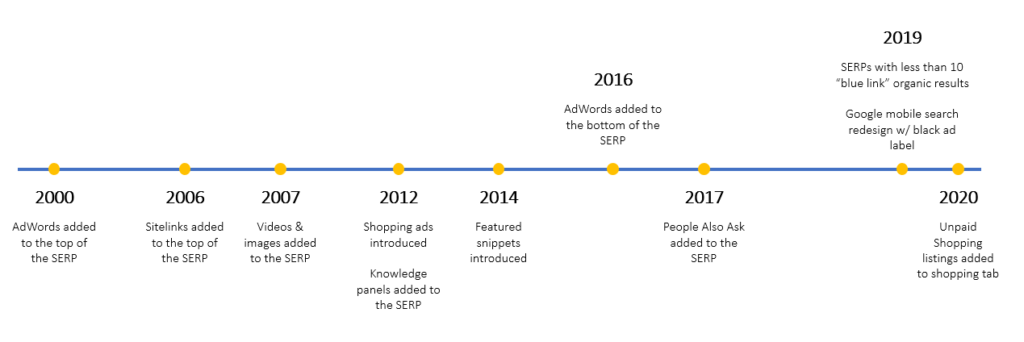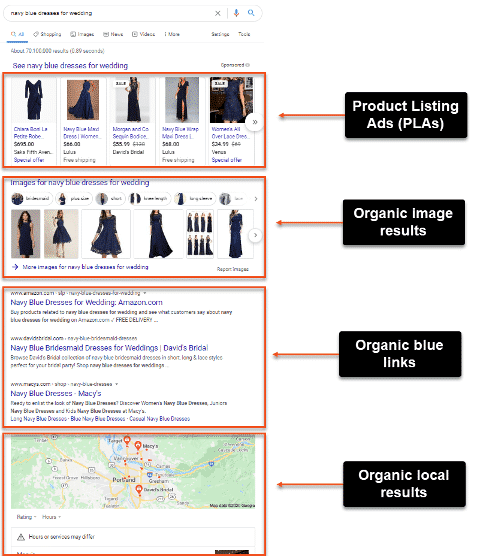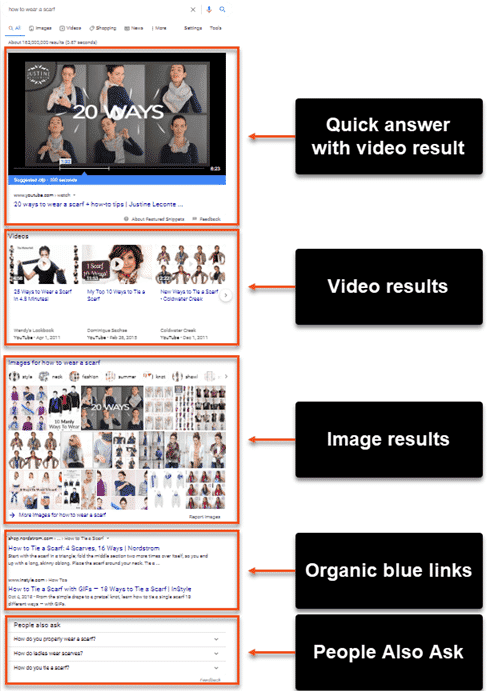Since 2000, search engine optimization (SEO) and search engine marketing (SEM) have played in the same space. Countless ad formats and rich result types have been added to the search engine results page (SERP), creating a more visual and competitive landscape.

In an integrated environment, SEM and SEO teams can collaborate, learn from each other, and provide incremental benefits, which include:
- Keeping one another informed of quickly changing business plans and respond with urgency.
- Ensuring consistent messaging in the SERP, contributing to a seamless user experience for customers.
- Uncovering patterns, anomalies, and opportunities that are more difficult for a single channel team to identify on their own. By having a larger team working regularly with a website, the collective knowledge of the business grows, offering greater fluency for understanding requests, and anticipating business needs.
Integrated teams can leverage various skillsets to benefit other channels with which they work. Specifically, teams can jointly contribute to projects related to messaging, on-page content / searcher intent, user experience, and optimizing SEO and SEM channels from a technical perspective.
Content & Messaging: Use Holistic Team Insights to Understand & Optimize for Search Intent
Searcher intent typically falls into one of two categories. The first category is transactional, where searchers are looking to purchase an item. The second category is informational, where searchers are looking to learn something. Both scenarios have different outcomes and require each team to adjust its content and messaging strategy to meet user needs and best utilize SERP features.
Transactional Searcher Intent
The query “navy blue dresses for wedding” yields a transactional SERP, characterized by paid and organic listings that closely match the search query. This includes ad formats that drive to product detail pages, such as product listing ads (PLAs), and organic blue links that lead to category pages showcasing products. The SERP often also includes organic rich results, such as images or Google’s 3-Pack localized results.

Transactional Queries & SEO Strategy:
A successful SEO strategy for transactional queries relies
heavily on using rich result SERP features and focusing on the following best
practices:
- Make the site easy to navigate with a crawlable
and intuitive taxonomy and strong internal linking signals. - Have
category or product listing pages, which provide an efficient user experience, with
targeted meta data, a variety of product listings, and strong on-page content. - Ensure
product detail pages have thorough product descriptions, images with optimized
alt text and file names, error-free structured data, and relevant product
attributes listed. - Leverage
rich result opportunities by ensuring Google My Business listings are complete,
video listings include detailed transcripts and video descriptions, etc.
Transactional Queries & SEM Strategy:
Most retail SEM programs heavily weigh ad support toward
transactional queries, as they often have a stronger return on investment
(ROI). Besides the keyword/target bid, search engines weigh an ad’s quality
score to determine rank. Quality score is an aggregated view of how well the ad
experience matches the users’ queries. Quality score is composed of:
- Expected click-through rate (CTR)
- Ad relevance to the query
- Landing page experience
Engines are looking for users to want to click through on ads and have a good experience. If an advertiser has a higher landing page experience (i.e., it is relevant for the searcher and the query), then the quality score of that ad will be higher and contribute to cost-per-click (CPC) savings compared to competitors. In SEO, ranking relevancy is determined by having a useful on-site experience, clearly relevant to the original query. Similarly, regular search query monitoring and negative query additions are important in SEM. They block irrelevant traffic from matching against ads, which both increases the conversion rate of traffic that does get through to site and helps to rank higher in auctions via increased quality score, without increasing bids.
Holistic Search Strategy for Targeting Transactional Queries
As the search landscape continues to become more competitive, utilizing organic and paid placements leads to more visibility and more opportunities for searchers to interact with your website. Integrated teams must balance the ROI required to achieve these SERP placements and identify opportunities that benefit the brand’s goals. Shared query reporting and holistic overall search ROI can be compiled and reviewed across teams to identify areas of further opportunity within either channel.
Informational Searcher Intent
Informational search queries are designed to answer an explicit or implied question asked by the searcher. SERPs for these queries tend to be characterized by prominent rich results that include quick answers or video content, news carousels, People Also Ask listings, and organic blue links. Some informational query SERPs will include paid listings. The example below for the query “how to tie a scarf” highlights several such SERP features:

Informational Queries & SEO Strategy:
Informational queries are an opportunity for SEO to drive
non-branded traffic, increase awareness, and build authority. Depending on the
vertical, content that answers informational queries can be an important
supplement to a business’s products and services, or it can be the product
itself. Retailers most often use long form writing, multimedia assets, and
interactive features to enhance a customer’s purchase journey and distinguish
themselves from competitor pages on the web. News publishers, nonprofit
organizations, financial service providers, and education sector websites, depend
heavily on content that can answer user questions in order to maintain
relevance and drive engagement.
Like transactional queries, a strong SEO strategy for
informational queries relies on targeting rich SERP features. To achieve these
placements, SEOs should consider using the following techniques:
- Conduct advanced keyword analysis and landscape research to understand core user questions.
- Audit a site’s existing content to understand which pages can be optimized to answer informational queries and to identify gaps where new content needs to be created.
- Structure content to align with the SERP feature being targeted.
- Use structured data to make the content easily digestible for search engines.
- Leverage image and video content to create a rich user experience and ensure SEO best practices are followed.
Informational Queries & SEM Strategy:
SEM has evolved a lot over the years, from historically only
going after terms that drive the best last-click ROI to now seeing the value in
being present on less conversion-focused queries for the purpose of filling the
funnel. In a world with many different attribution ****** available, we now have
more flexibility to distribute conversion credit to informational queries when a
portion of that traffic comes back and converts via another interaction. For
this, we recommend one of the following attribution ******:
- Data-driven attribution
- Time decay
- Linear
For these types of queries, traffic is best matched to long-form content (typically blog) pages built out by SEO teams. Within SEM, this traffic is best acquired via running either text ads, which target keyword-matched queries to chosen landing pages, or Dynamic Search Ads (DSAs), which target relevant queries to designated types of landing pages. For SEM, the agreed upon goals of this traffic and the volume of traffic coming through these terms will help determine which ad format is best for running support. For clients just starting out in advertising on informational queries, we recommend starting with DSA targeting on a smaller budget and an automated bid strategy focused on driving traffic. From there, begin breaking out either more granular DSA targets or stand-alone text ads for high-volume terms, as well as testing into more conversion-focused bid strategies.
Holistic Search Strategy for Targeting Informational Queries
For many brands, it can be difficult to justify the SEM expense of targeting informational queries, as it is typically a higher funnel strategy or branding play. However, by leveraging SEM data, SEO can use paid insights to understand where there is more ROI to be had for informational content. This creates a win-win situation for the brand, which can more easily justify the expense of creating the content.
Use Cases: Technical SEO + Technical SEM
Organic Merchant Center Programs
Feed management is a sub-specialty that many SEM teams help run, given that 89 percent of non-brand Google paid search clicks now come from feed-powered Shopping ads, according to the Merkle Q1 2020 Digital Marketing Report. Until recently, there was little focus on it from SEOs, since most SEO work is focused on crawling, indexation, and ranking. With the Google announcement of Unpaid Shopping Listings under the shopping tab, both teams are given an opportunity collaborate by:
- Ensuring the product feed adheres to Google
Merchant Center best practices. - Building
reporting dashboards for Organic Shopping Listings that incorporate sessions,
revenue, and other relevant organic metrics. - Working together to further optimize the
feed with title updates, image testing, description changes, and google product
categorization improvements.
Crawling and Navigation
From an SEO perspective, crawling and navigation are key
considerations that impact page discovery for crawlers. Alternately, SEM
results are based on a bid, but also on the relevancy and expected CTR of that
product or group of products in context of both the user’s query and what the
search engine knows about that user and his or her online behavior.
Leveraging SEM data against SEO data can also lead us to discover orphaned PDPs and categories that can be difficult to find. To help identify them more quickly, we can run an analysis of what is over-indexing in sales via SEM and cross reference those products or categories to the user’s on-site, navigational experience finding them. This is a quick and clever way to ensure products that might be under-performing outside of SEM can be optimized to have a chance at better performance on-site and in organic search.
SEM, SEO, and the User Experience
When given similar bids, the SEM team can see what
individual products the search engines see as winners on the SERP and what
products will stand out against the competition, get traffic onto the client’s
site, and drive conversions. As a pull marketing channel, product traffic and
sales trends are typically very reflective of seasonal demands across the
entire product catalog. Using SEM data to our advantage, we can look at product-level
reporting and see what products over index in sales via SEM compared to non-SEM
all-site sales. Narrowing to the top outlier products reveals interesting
implications to begin answering broader questions, such as: “Which products
should we pin to show at the top of a category page?” “What products would be
winners, in that they had more visibility?” “Which products should be moved to
clearance, given that they convert poorly even with a lot of highly relevant
traffic?” In these instances, SEM product performance can help us make more
informed assumptions about what appeals to a business’s user base on-site and across
channels.
From an overall business perspective, both SEM and SEO teams are often asked, “What can we do to better support x page?” For SEM, sometimes those pages would be low volume or wouldn’t be expected to return well given paid ad support. For SEO, those might be pages that are technically sound and keyword optimized, but they are having a hard time ranking in highly competitive SERPs. This is a great opportunity for both teams to come back to a customer-centric perspective and collectively ask ourselves, “Regardless of channel, how would we as users want to find and experience this page as part of our shopping journey?” It might be as simple as ensuring a page is featured in the header navigation, footer content, and referenced from relevant PDPs throughout the site. Whether the searcher direct loads, clicks through a paid or unpaid listing, or comes in via email, we want that page to be visible and easily accessed, such that it will enhance the searcher’s experience with the brand.
Using SEO & SEM to Create a Seamless User Experience
Staying siloed in either an SEO or SEM context can feel
comfortable for those who have never worked in integrated search. While
stepping outside of established routines to try new cross-channel techniques
may feel intimidating, communication is the essential first step to creating a
more collaborative strategy.
As with cross-channel collaboration of any kind, the goal is
to create a seamless experience for consumers, no matter how they’re
interacting with your brand. Outside of the above examples, have SEM and SEO
teams meet regularly to discuss what they’re working on and their channel goals.
This will result in interesting collaborations. It will help search teams to
speak one another’s language and recognize situations where one opinion or
perspective could create additional value for another business or business
partner.
Even for those who are only able to work formally within a siloed
SEM or SEO team, curiosity about other channels will still yield benefits.
There may be some limitations on your ability to apply the techniques mentioned
here. However, the practice of asking user-centered questions that consider the
holistic search journey will position you to notice and articulate where
opportunities exist across all channels.
